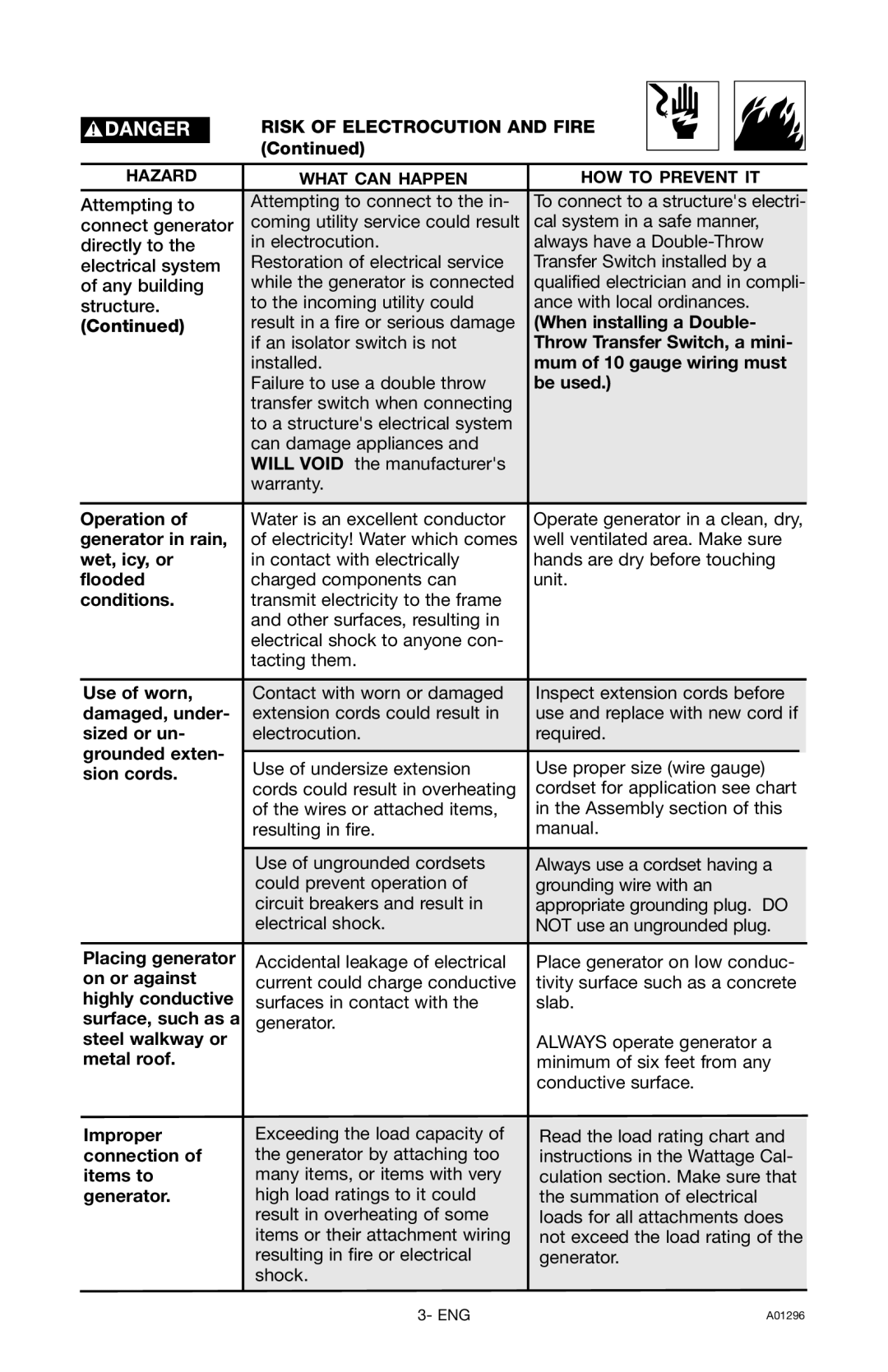
RISK OF ELECTROCUTION AND FIRE (Continued)
HAZARD | WHAT CAN HAPPEN | HOW TO PREVENT IT | ||
Attempting to | Attempting to connect to the in- | To connect to a structure's electri- | ||
connect generator | coming utility service could result | cal system in a safe manner, | ||
directly to the | in electrocution. | always have a | ||
electrical system | Restoration of electrical service | Transfer Switch installed by a | ||
of any building | while the generator is connected | qualified electrician and in compli- | ||
structure. | to the incoming utility could | ance with local ordinances. | ||
(Continued) | result in a fire or serious damage | (When installing a Double- | ||
| if an isolator switch is not | Throw Transfer Switch, a mini- | ||
| installed. | mum of 10 gauge wiring must | ||
| Failure to use a double throw | be used.) | ||
| transfer switch when connecting |
|
| |
| to a structure's electrical system |
|
| |
| can damage appliances and |
|
| |
| WILL VOID the manufacturer's |
|
| |
| warranty. |
|
| |
|
|
|
| |
Operation of | Water is an excellent conductor | Operate generator in a clean, dry, | ||
generator in rain, | of electricity! Water which comes | well ventilated area. Make sure | ||
wet, icy, or | in contact with electrically | hands are dry before touching | ||
flooded | charged components can | unit. | ||
conditions. | transmit electricity to the frame |
|
| |
| and other surfaces, resulting in |
|
| |
| electrical shock to anyone con- |
|
| |
| tacting them. |
|
| |
|
|
|
| |
Use of worn, | Contact with worn or damaged | Inspect extension cords before | ||
damaged, under- | extension cords could result in | use and replace with new cord if | ||
sized or un- | electrocution. | required. | ||
grounded exten- |
|
|
| |
Use of undersize extension | Use proper size (wire gauge) | |||
sion cords. | ||||
| cords could result in overheating | cordset for application see chart | ||
| of the wires or attached items, | in the Assembly section of this | ||
| resulting in fire. | manual. | ||
|
|
|
| |
| Use of ungrounded cordsets | Always use a cordset having a | ||
| could prevent operation of | grounding wire with an | ||
| circuit breakers and result in | appropriate grounding plug. DO | ||
| electrical shock. | NOT use an ungrounded plug. | ||
|
|
|
| |
Placing generator | Accidental leakage of electrical | Place generator on low conduc- | ||
on or against | current could charge conductive | tivity surface such as a concrete | ||
highly conductive | surfaces in contact with the | slab. | ||
surface, such as a | generator. |
|
| |
steel walkway or |
| ALWAYS operate generator a | ||
metal roof. |
| minimum of six feet from any | ||
|
| conductive surface. | ||
|
|
|
| |
Improper | Exceeding the load capacity of | Read the load rating chart and | ||
connection of | the generator by attaching too | instructions in the Wattage Cal- | ||
items to | many items, or items with very | culation section. Make sure that | ||
generator. | high load ratings to it could | the summation of electrical | ||
| result in overheating of some | loads for all attachments does | ||
| items or their attachment wiring | not exceed the load rating of the | ||
| resulting in fire or electrical | generator. | ||
| shock. |
|
| |
| 3- ENG | A01296 | ||
